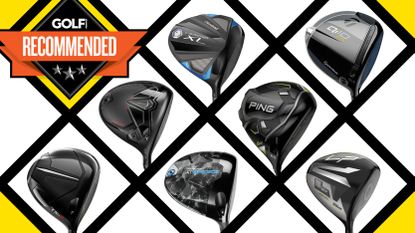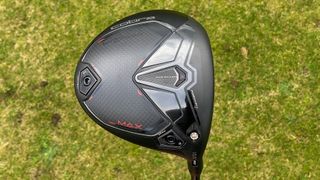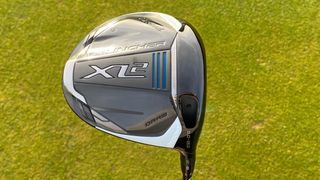Best Drivers For Slicers 2024
We take a look at the best drivers that will stop you slicing tee shots


One sure fire way to ruin a scorecard and make golf a lot less enjoyable is slicing the ball off the tee. It's one of the most destructive shots for amateur golfers as a wild right miss will usually find trouble, whether its out of bounds, trees or maybe even a water hazard. Trouble often lurks on the right and a slice will find it. Even if you manage to avoid trouble, a slice causes you to lose distance, making your next shot more difficult and leading to higher scoring.
You will also go through golf balls at an alarming rate, which can be very expensive. In short, a slice can completely ruin a golfer's enjoyment of the game. There is help available though.
Most of the major golf brands produce drivers that have 'draw biased' technology and will offer help to the wayward slicer. The best golf drivers tend to come with three or four different models on offer and one of those is usually designed to minimise the damage done by those big right misses. There are two main ways to do this, adding extra weighting in the heel side of the club head is one way and adding offset to help square, or even slightly close the club face at impact is another.
WATCH: We run through the performance of the best drivers in 2024
You should tailor your expectations though as there is no miracle club to completely wipe out a wild slice and turn that big banana shot into a Rory McIlory style high booming draw. However, the set up of these clubs will help to keep the massive slices at bay and turn those lesser slices into a straighter, more powerful ball flight.
Below we have compiled a list of the best anti-slice drivers we have tested but, if you're looking for something more specific, check out our guide on the best golf drivers for beginners, the most forgiving golf drivers or the best drivers for distance.
The Quick List

The Cobra Darkspeed Max offers strong performance in a pleasing, sophisticated aesthetic. The draw-bias and forgiving head makes this a must-try for the slice plagued golfer.

Our top pick when it comes to accuracy is the Qi10 Max from TaylorMade as the super stable head is resistant to twisting even towards the extremes of the face.

In our testing we found the G430 SFT to be long, easy to launch and ideally suited to a wide variety of golfers thanks to the exceptional forgiveness on offer.

The Ai Smoke Max D driver from Callaway is very easy to launch and packs a real punch, whilst we found it to be very forgiving on mis-hits as well.

The Launcher XL 2 Draw driver from Cleveland is rammed with good performance and comes at an appealing price. There is also nice attention to detail in the engineering.

Foor those beginning their golf journey the Launch Pad from Wilson is a fine choice. It's very easy to launch and will therefore make life much easier off the tee those who lack consistency.
Best Drivers For Slicers - Best Anti Slice Drivers
Why you can trust Golf Monthly
Best overall

Specifications
Reasons to buy
Reasons to avoid
We love this driver and it was also our top pick for the best drivers for beginners due to how user-friendly it is. It's also fantastic for helping with a slice, and our tester found it nigh on impossible to miss to the right! This was primarily down to the back and heel weighting, which allowed us to adjust the draw bias in the head and completely take the right miss out of play.
The aesthetics of the Cobra Darkspeed Max are stunning, yet the looks were eclipsed by the overall performance in testing, which quite frankly blew us away. The draw bias is second to none and while the spin numbers are a little higher than usual, that is by design and will help golfers who struggle getting the ball airborne.
The dark look is very fetching and we think this driver will look great in any golf bag. Over the ball it sits very square at address and the carbon effect crown and minimalist Cobra logo give it a very sophisticated look.
- Read our full Cobra Darkspeed Max Driver Review
Most accurate

Specifications
Reasons to buy
Reasons to avoid
Thanks to the brand's exceptional marketing there is always a stir when TaylorMade release a new driver and this year was no different when the Qi10 range hit the market. The standout model in the Qi10 family is the Max, which for those who don't know, is the club that inspired the Qi10 range as it is the first TaylorMade driver to reach the 10K mark when it comes to 'Moment of Inertia', a measurement of a club's stability and resistance to twisting.
While the Max version is ideal for beginners and slicers, it will also find a home in the bag of players at the lower end of the handicap scale too as it's a fantastic all round driver. For some reason TaylorMade seem to be shying away from the anti-slice angle and have deliberately omitted any nod to a draw bias out of the name or marketing for the Max. Perhaps they feel that perception of any flight bias might limit their target market, but we can tell you that in our testing there was an evident draw bias on impact. Not as prevalent as other models in this guide, specifically the Cobra Darkspeed listed above, but it was there.
The stand out feature of the model though is the stability and forgiveness, which is really impressive. This exceptional forgiveness makes this one of the best TaylorMade drivers on the market.
- Read our full TaylorMade Qi10 Max Driver Review
Most forgiving

Specifications
Reasons to buy
Reasons to avoid
Another driver that also featured on our guide to the best drivers for beginners, the Ping G430 SFT is a fantastic driver that features a moveable weight which can be set in either a Draw or Draw+ setting. According to the brand's engineers the Draw + setting delivers seven yards more draw bias versus the G430 Max version in neutral. Seven yards is not to be sniffed at as it can be the difference between fairway and rough, or even rough and the water!
Unlike some draw bias drivers, we noted that the G430 SFT sits fairly square behind the ball which will appeal to better players who don't like offset in a driver. The neutral looking set up along with the generous profile promotes a confidence-boosting appearance over the ball, which is half the battle for the golfer who struggles off the tee. Something else that we think will inspire confidence is that the head is slightly longer from front to back, which frames the ball nicely at address.
The results in testing were very good. This driver went considerably longer than others on this list, which is nice but not a reason in itself for choosing it. You want to know if it delivered on the draw bias promised by Ping, right? Well the answer is yes it did. Our dispersion chart leaned heavily to the left, demonstrating that the technology is doing its job nicely.
- Read our full Ping G430 SFT Driver Review
Best for launch

Specifications
Reasons to buy
Reasons to avoid
The new Callaway Paradym Ai Smoke range looks stunning with its new grey colorway prominent in the three models available. The Max D is the draw bias model and features a large profile that pushed the manufacturing restrictions to the limits in pursuit of the highest MOI possible. The result of this is a large, confidence inspiring head that should really appeal to anyone who lacks assurance on the tee.
The tag line for this driver is ‘Sweeter From Every Spot’ and we were keen to find out if that was accurate or just a catchy marketing slogan. We are happy to say that our testing showed that not only was this club very easy to get airborne but the draw bias was evident without being too excessive. There are more severe draw models on the market but our testing showed a nice, subtle right-to-left flight. There is also the added bonus of a higher launch that will be really beneficial for seniors as well as beginners and slicers.
All things considered, we feel that forgiveness is probably the main stand-out feature, which is hardly surprising given the face was designed by A.I. with the aim of having multiple sweet spots. The addition of a rear weight which has been strategically placed in order to maximise MOI and draw bias also helps in this regard.
- Read our full Callaway Paradym Ai Smoke Max D Driver Review
Best looking

Specifications
Reasons to buy
Reasons to avoid
The Launcher XL 2 Draw is a lightweight, draw-bias driver from Cleveland Golf and is aimed at players with a slow to moderate swing speed, so it's ideal for the beginner golfer as well as those who suffer from the dreaded slice. The color and finish of this driver look impressive and create a premium aesthetic that give this club a more expensive look compared to the price tag it carries.
In our testing we noticed a firm impact and fairly loud acoustics which will perhaps not appeal to all, but there was ample ball speed produced and we felt that the ball came off the face very quickly.. In addition to giving us good ball speed, we also found it to be exceptionally easy to launch so that will please the demographic this driver is aimed at. The spin was on the higher side but again that will benefit beginners and the beauty of this driver is that the adjustable hosel means that you can reduce or increase those spin numbers to the desired preference, so the new golfer can change the settings as their game improves, reducing the need to change to a new driver.
- Read our full Cleveland Launcher XL 2 Draw Driver Review
Best for beginners

Specifications
Reasons to buy
Reasons to avoid
It's a slightly older model compared to some on this list, but the Wilson Launch Pad is designed to be one of the most forgiving drivers that money can buy and it's also one of the best budget drivers. Forgiveness in a driver usually refers to what happens when shots miss the sweet spot on the club face, but there are other elements that come into it and in terms of forgiveness in a driver the Launch Pad is perfect for the new golfer, a slicer or indeed anybody struggling for height and accuracy off the tee.
Everything about the design of the Launch Pad is designed to help the struggling golfer, including the slicer. The lie angle is two degrees upright to help square up the face at impact and aid with launch, while the face itself sits noticeably closed behind the ball which is designed to prevent the open face contact that causes a slice. As an extra insurance against the big right miss, Wilson has also added heel side weighting in the head to promote more of a draw.
It certainly works, as our tester was able to consistently produce a high draw shot shape of up to 10 - 15 yards. This is a significant number if you are a slicer of the golf ball.
While being far from the longest driver on the market, if you want a driver to help you get the ball in the air and straighten out your flight, this is a fine choice, especially given the value on offer.
- Read our full Wilson Launch Pad Driver Review
How we test
When it comes to product testing, our reviews and buyers' guides are built upon a rigorous testing procedure combined with the knowledge and experience of our test team. Our driver testing is headed up by Staff Writer Joe Ferguson, a PGA Professional who has worked in the golf industry for nearly 20 years. Joe is ably assisted by technical editor Joel Tadman and both Joe and Joel have been testing golf clubs for many years and can efficiently assess the biggest product releases and then convey the pros and cons eloquently to you the reader.
When it comes to drivers specifically, our process for testing usually begins with attending product launches where we can speak to manufacturers to get a full understanding of the new technology on display. We then hit the golf clubs indoors, usually at Foresight Sports, where we test the products with premium golf balls on a launch monitor.
Outdoor testing is the next port of call and this usually takes place at West Hill Golf Club, a course in Surrey with top-notch practice facilities. It is important to note that we are always completely honest in our reviews and as such no manufacturer can pay for a good review.
How to choose a new driver
You've probably already asked yourself whether you need to buy a new driver, but there's a few key things to consider when investing in a new driver, especially one that can help with your slice. Hopefully answering these questions will narrow your search down slightly and make comparing between various models much easier.
When purchasing a new big stick, it is crucial to ask yourself just what you need from it. Is distance your main priority or are you looking for something to help you find more fairways? We'd always recommend a custom fitting with a PGA Pro but if you know what you're looking for you can make an informed decision.
If you want to eliminate a slice then there are drivers out there that will help, so that should be your first port of call. We have chosen the best current models available for this guide but there are older models out there too that you might want to consider.
FAQs
Do offset drivers help slice?
Yes they do. How? Well the club face sits slightly behind the hosel, which delays the arrival of the club face to the ball, allowing it more time to arrive square at impact. Some drivers - like the Callaway Big Bertha 21 driver - have a very pronounced a visible offset at address whereas some manufacturers try to hide the offset look. It's an entirely personal preference as to whether you like the look of an offset driver, but they will help combat a slice.
What is the best driver to help with a slice?
All of the drivers in this guide will help golfers who tend to slice the ball. Important things to keep an eye out for are offset and a heel weighting that will combine to keep the club head square or even closed at address.
Does a higher loft reduce slice?
Yes. While those who tend to slice the ball off the tee often want to see a lower ball flight, adding extra loft to your driver will add back spin and create a more stable ball flight with less side spin. We'd recommend having a driver with 10.5° as a minimum, but you may want to crank it up even higher. Trial and error is the way to go. See what works for you.
Get the Golf Monthly Newsletter
Subscribe to the Golf Monthly newsletter to stay up to date with all the latest tour news, equipment news, reviews, head-to-heads and buyer’s guides from our team of experienced experts.

Joe has worked in the golf industry for nearly 20 years in a variety of roles. After a successful amateur career being involved in England squads at every age group, Joe completed his PGA degree qualification in 2014 as one of the top ten graduates in his training year and subsequently went on to become Head PGA Professional at Ryder Cup venue The Celtic Manor Resort. Equipment has always been a huge passion of Joe’s, and during his time at Celtic Manor, he headed up the National Fitting Centres for both Titleist and Taylormade. He’s excited to bring his knowledge of hardware to Golf Monthly in the form of equipment reviews and buying advice.
Joe lives in North Devon and still plays sporadically on the PGA West region circuit. His best round in recent years came earlier in 2023 where he managed a 9 under par 63 at Trevose GC in a Devon & Cornwall PGA Tournament.
Joe's current What's In The Bag?
Driver: Switch between Ping G430 Max 10K & TaylorMade Qi10 - both with Fujikura Ventus Black 6-X
Fairway wood 1: TaylorMade BRNR Copper Mini Driver - Fujikura Ventus Black 7-X
Fairway wood 2: Callaway Paradym Ai Smoke TD 5 Wood - Fujikura Ventus Black 8-X
Irons: TaylorMade P7CB 3-PW with Dynamic Gold Tour Issue X100 shafts
Wedges: Callaway Opus 50, 54, and 60 degrees - Project X LS 6.0 shafts
Putter: Odyssey Toe Up #9
Ball: TaylorMade 2024 TP5x
Grips: Golf Pride Tour Velvet 60R
Bag: Vessel Player IV Pro DXR Stand
- Matt CradockStaff Writer
-
 Ruoning Yin Claims Historic Victory In Home Event At Buick LPGA Shanghai
Ruoning Yin Claims Historic Victory In Home Event At Buick LPGA ShanghaiThe 22-year-old dazzled in the final round, as Yin produced a blemish free eight-under-par 64 to claim a fourth LPGA Tour title and first in China
By Matt Cradock Published
-
 Black Desert Championship Final Round Tee Times
Black Desert Championship Final Round Tee TimesMatt McCarty leads a four-way tie for second at 19-under-par, with the American searching for a first PGA Tour win after recently graduating from the Korn Ferry circuit
By Matt Cradock Published